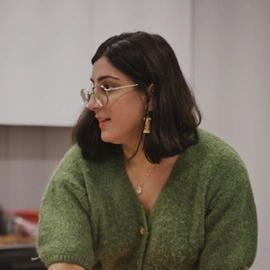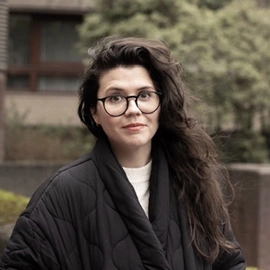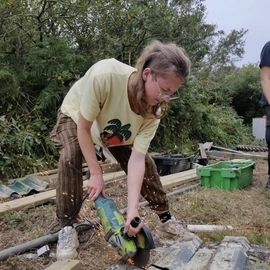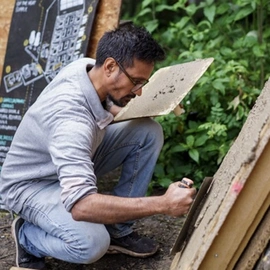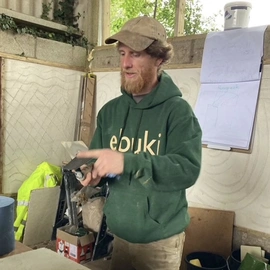- Sketchbook (Ongoing)
- The Scoop / Writing
- Craftspace x Serendipity Art festival, Goa
- Heal, Home, Hmmm x Intervention Architecture at V&A Museum
- A String of Love x without SHAPE without FORM
- A sickness is spreading, it’s turning us blue
- Comfort Near Me
- Made in the Middle
Courses for Dis-Course(s)
The Podcast and Publication
Material Matters- New Contemporaries
- Manji, Charpai, Daybed x Greenwich & Docklands International Festival
- Don’t play with your food
- Jalebi Press
- Hospital Rooms x Sandwell CAMHS
- Rhythm with Osman Yousefzada
- Aftercare with Liverpool Biennial
- Comrades (Midlands) with Outside In x EXPLORERS project
- 2023 ++
- Arts Council Collection Acquisitions 2022
- Courses for Dis-Course(s)
- Quisse of the Komagata Maru
- Khao, peyo, aish karo, but don’t hurt anyone’s heart
- Care Work ft Desi and Disabled
- But what if I gave myself an ounce of the care I show for others?
- Archive 2019 - 2022 ++
About- Bazaar
- Contact
- Disabilty Disclosure
- Experience etc
- Fun
- Contact Details
Email roodhissou@gmail.com Twitter @roodhissou Instagram @roodhissou
- © Roo Dhissou and Jalebi Press 2025. Please ask for permission when referencing my writing because it may contain original references to my PhD, or using my images, as they may belong to one of my many photographer friends.
Heal, Home, Hmmm x Intervention Architecture
- Heal, Home, Hmmm is a new sculptural pavilion by artist Roo Dhissou, commissioned by the V&A for London Design Festival 2025. Made using clay excavated from HS2 sites and traditional mud building techniques, the work explores how access, care, and environmental responsibility can shape the structures we build, both physically and socially. The pavilion will be on display at the V&A, accompanied by performance, sound, and public programming.
Embracing traditional Punjabi mud building techniques, the pavilion and sound installation explores how access, care, and environmental responsibility can shape the structures we build, both physically and socially. Find out more here.
On now until Sunday, 19 October 2025
V&A South Kensington
10.00 – 17.30
Cromwell Road
London, SW7 2RL
Heal, Home, Hmmm was co-designed by artist Roo Dhissou with Intervention Architecture, built using reclaimed HS2 clay from Rescued Clay, and features a sound installation created in collaboration with sound artist Oliver Romoff.
Questions Behind the Work
Heal, Home, Hmmm began with a set of questions rather than fixed answers. What would the UK housing crisis look like if we remembered how to build for repair and return to soil, rather than demolition and waste? How do we make structures that breathe, regulate, and hold our bodies with care? What might it mean to host artists and communities with disabilities, chronic illness, and access needs in spaces that also honour ecological responsibility?
These questions are not separate. They are entangled. For me, material justice, disability justice, and social justice are inseparable. Working with unfired clay became both a method and a metaphor: it cracks, it can be repaired with water and fibre, it carries memory, and it can return to the earth. That ethic of maintenance over disposability shaped every choice in the project.
I was also inspired by memory and place. My childhood in Punjab was filled with mud houses, tandoors and chulas. These forms of earth-building were never nostalgic to me; they were techniques, ways of living with climate and community. Through this pavilion, I am re-learning them in the present, adapting them to ask what futures might be possible if we build with repair, access and care as our foundations.
From First Sketch to Final Pavilion
The story of Heal, Home, Hmmm begins in 2024 during my time with Civic Square and Material Cultures, where I first started sketching ideas for a shelter shaped by Punjabi mud huts, tandoors and chulas. Those early drawings were rooted in memory and material justice, asking how clay, straw and timber might carry stories of home and care into new forms.
In November 2024, Meneesha Kelly at the V&A approached me with an open brief: I could make whatever I wanted. I knew instantly this was the moment to bring those sketches to life. But I also knew I couldn’t do it alone.
I reached out to Anna Parker at Intervention Architecture, whose skills in drawing and structural design could turn my ideas into something buildable. Together, we began redrawing the pavilion. It was Anna who suggested working with the vast amounts of clay being unearthed by HS2. At first we searched for clay in Birmingham, following many leads, until our journey eventually brought us to Prashant Patel, co-founder of Rescued Clay.
The generosity we were met with was unparalleled. Prashant opened the doors of Rescued Clay to us, offering space, materials, time and support. What began as fragile sketches quickly became solid panels of reclaimed earth, built through kindness and collaboration.
Harrison Dunn, took mine and Anna’s initial drawings and transformed these into digital renders with build guides that we used to help guide us, his brief was Ikea flatpack!
From those first experiments to the CNC-cut timber frames, from hand-trowelled cob boards to the final pavilion at the V&A, every stage carries these relationships within it. This is a work shaped by care as much as by clay, a prototype of how we might build differently, together.
The work is a testament to the many people who helped design build, craft and created space for the pavilion to exist. each and every person listed below is indefinitely embodied in Heal, Home, Hmmm.
Activating the Pavilion
From the beginning, I knew Heal, Home, Hmmm could never just sit silently as an object in a museum. Clay, straw and timber carry memory, but they also ask to be lived with. I wanted the pavilion to breathe, to host, and to invite people in.
I worked with sound artist Oliver Romoff, a frequent collaborator, who created a multi-layered sound installation embedded into the structure. His compositions draw from field recordings, rhythm and texture, allowing the pavilion itself to hum with life, not only to be seen, but to be felt and heard.
As part of this, Olly recorded me speaking the guiding questions of the work as vocals, and playing the taus as a spiritual response to each question through Raag Asa. I am currently learning to play the taus with the Gurmat Sangeet Academy (GSA), and it was important for me that this practice was part of the pavilion. From these recordings, Olly layered and expanded the soundscape with his own textures, creating a piece that moves between my voice, the taus, and his sonic interventions.
I also invited the Gurmat Sangeet Academy to perform in the V&A’s Lecture Theatre for September’s Friday Late. Their Sikh devotional music extends the work into collective listening, resonance and reflection. Find out more here.
Beyond sound and performance, the pavilion is also activated by objects and forms I made with my own hands. I wove Punjabi peedis (traditional stools), which are placed inside, outside, and on the roof of the pavilion, alongside an image of my childhood home in Punjab. I also built a cob clay oven (chula), and worked with Giovanni Agostini to design and create a clay tawa, grounding the work in everyday tools of cooking, fire, and sustenance. The pavilion is also accompanied by a draft guide to West Midlands materials, produced during my time with Material Cultures and Civic Square, mapping local, sustainable resources and practices.
And throughout, the pavilion itself is a living activation. It was co-designed to be accessible, multi-sensory and generous: step-free entry, tactile surfaces and sounds. Access here is not an afterthought but a foundation.
Together, these activations mean the pavilion is never static. It is a shelter, a stage, and a host for gathering, an ecology of care: where sound, performance, memory, and community can meet.
An Invitation
I invite you to step inside the pavilion slowly. Touch the clay walls with your hands. Sit on the floor or rest wherever feels comfortable. Remove your shoes if you wish, feel the ground beneath you, and let yourself be held by the space.
Listen to the sounds that move through the structure. Notice how the walls breathe, how the air shifts, how your body feels in relation to others. The pavilion is not only something to look at, but a place to ground yourself and take in the questions it carries: How do we build with care? How do we make together? What futures can we shape when access and justice are foundations, not afterthoughts?
This is a space for pausing, for listening, for imagining otherwise.
Listen to the audio here:
and find Transcript here.
Anna Parker
Harrison Dunn
Rescued Clay:
Victor Pedrosa
Prashant Patel
Giovanni Agostini
V&A Contemportary Team:
Faunsia Tucker
Jasprit Singh
Katya Spiers
Kristian Volsing
Meneesha Kaur Kellay (Initial Commission)
Sarah Shu Lin (Marketing)
Ava Grauls
Cat Macdonald
Peter Kelleher
Fred Hubble
Josh Sutton
Leah McIntyre
Liang-Jung Chen
Arjun Singh Assa
Oliver Romoff
Sophie Wall
Larissa Shaw
Ashley Park
Fillo Deportaberta
Sebastian Wells
Daniel Sinclair
Christen Faver
Aisling Ward
Jaspreet Kaur
Yasmeen Thantrey
Seva team from WSWF
Exova Events CNC
Freya Bruce
Harry Johnson
Minerva Works, Park Royal
Johnny Brewin
OPDC
Nelson the Cat
Rayan Bakery
CIVIC SQUARE
Hood Futures Studio
Material Cultures
Wolves Lane
Ebuki
Calch a Chlai Cymru
Dark Matter Labs
Absolute Beginners
Grand Union Gallery and Studios
Sancha
“A new sculptural pavilion by artist Roo Dhissou, the recipient of the V&A’s Emerging Designer Award. Embracing traditional Punjabi mud building techniques, the pavilion and sound installation explores how access, care, and environmental responsibility can shape the structures we build, both physically and socially” - LDF 2025
Find out more here
Global Design Forum: (In)finite Realities - Panel Talk
Exploring Transformative Practices in the Built Environment
The discussion will centre around how our practices are challenging inherited structures and redesigning frameworks, whether material, civic, spatial or systemic; to support life-ennobling, regenerative futures. Each of our panellists' practices offers a unique and crucial perspective on this transformation, and these are brought together in dialogue for an entangled conversation on transformative justice. With thanks to our Curatorial Partner STIR.
Find out more here
